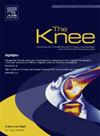Neuromuscular control of the knee and hip and its relationship with function in women with patellofemoral pain
IF 2
4区 医学
Q3 ORTHOPEDICS
引用次数: 0
Abstract
Background
The combined assessment of subjective and objective measures is essential to understand functional impairment in individuals with patellofemoral pain (PFP) and to guide appropriate rehabilitation strategies. The objective to was investigate the relationship between objective and subjective function and neuromuscular control of the hip and knee in women with PFP and asymptomatic women.
Methods
Data were collected from 30 women (22.56 ± 4.21 years) with PFP and 30 asymptomatic women (21.10 ± 1.68). Initially, anthropometric data were collected and the Anterior Knee Pain Scale (AKPS) was applied. Subsequently, objective function was assessed using four tests: step descent, single-legged chair rise, anterior hop, and lateral hop. On the second day, knee extensor, hip extensor, and hip abductor torque were assessed on an isokinetic dynamometer. The protocol consisted of 3 concentric contractions at a speed of 60°/sec for the knee joint and 30°/sec for the hip joint. For statistical analysis, the independent t-test was applied to compare variables between groups and the Pearson correlation test, with a significance level of p < 0.05.
Results
Women with PFP have a deficit in the ability to produce maximum hip and knee force during concentric contractions (p < 0.05). Moderate correlations were found in strength and TDT and functional performance.
Conclusion
The deficit in the ability to produce muscle strength and power of the hip and knee negatively interferes with functional performance and should therefore be considered in rehabilitation.
髌骨股痛患者膝关节和髋关节的神经肌肉控制及其与功能的关系
背景:综合评估主客观指标对于了解髌股疼痛(PFP)患者的功能损害并指导适当的康复策略至关重要。目的是研究女性PFP和无症状女性的客观和主观功能与髋关节和膝关节神经肌肉控制之间的关系。方法收集30例PFP患者(22.56±4.21岁)和30例无症状患者(21.10±1.68岁)的资料。最初,收集人体测量数据并应用前膝关节疼痛量表(AKPS)。随后,通过四项测试评估目标功能:台阶下降、单腿椅子上升、前跳和侧跳。第二天,在等速测功机上评估膝关节伸肌、髋关节伸肌和髋关节外展肌扭矩。该方案包括3次同心收缩,速度为膝关节60°/秒,髋关节30°/秒。统计分析方面,组间变量比较采用独立t检验,Pearson相关检验,显著性水平为p <;0.05.结果:患有PFP的女性在同心收缩时产生最大髋关节和膝关节力量的能力方面存在缺陷(p <;0.05)。强度与TDT和功能表现存在中等相关性。结论髋关节和膝关节肌力和力量产生能力的缺陷会对功能表现产生负面影响,因此在康复治疗中应予以考虑。
本文章由计算机程序翻译,如有差异,请以英文原文为准。
求助全文
约1分钟内获得全文
求助全文
来源期刊

Knee
医学-外科
CiteScore
3.80
自引率
5.30%
发文量
171
审稿时长
6 months
期刊介绍:
The Knee is an international journal publishing studies on the clinical treatment and fundamental biomechanical characteristics of this joint. The aim of the journal is to provide a vehicle relevant to surgeons, biomedical engineers, imaging specialists, materials scientists, rehabilitation personnel and all those with an interest in the knee.
The topics covered include, but are not limited to:
• Anatomy, physiology, morphology and biochemistry;
• Biomechanical studies;
• Advances in the development of prosthetic, orthotic and augmentation devices;
• Imaging and diagnostic techniques;
• Pathology;
• Trauma;
• Surgery;
• Rehabilitation.
 求助内容:
求助内容: 应助结果提醒方式:
应助结果提醒方式:


